|
SKF executive explains
company's philosophy on Fair
Stuart H. Smith, Vice President
and Assistant to the President, presents details of SKF's participation.
|
It has been said in critical appraisal of the SKF Pavilion
at the New York World's Fair 1964/65, that this Pavilion represents
one of the finest examples of pure exposition philosophy on the
Fair grounds.
This opinion is well taken and implies a great many very subtle
innovations which must be examined in order to appreciate the
excellent marriage of architecture and exhibition which is manifest
in the final product.
In order to fully appreciate this Pavilion, it is necessary
to examine it from several basic points of view:
- What is the purpose of the Pavilion?
- What problems did the project present?
- How were those problems solved?
As is the case in most any art form, a set of basic ground
rules must be established prior to any attempt to evaluate the
project. In the case of the SKF Pavilion, these rules emanated
from the decision by SKF Industries management to participate
in the Fair. At the beginning, there was a great deal of question
as to why a manufacturer of ball and roller bearings, whose market
is basically in industry itself, would choose to participate
in a fair attended in the vast majority by the general public.
|
Official World's Fair area map
points up major exhibit areas.
 |
|
While it is true that the product of our company is the ball
and roller bearing, it is equally true that we are concerned
with a facet of technical and industrial development which is
inseparable from the present and future needs of the public,
as well as industry, for smoother, safer and more efficient methods
for keeping Man and materials on the move. We call this technique
"motion engineering" |
|
We feel it is important for the public to know about motion
engineering and to recognize, of course, that we cannot expect
to "sell" bearings as a result of our participation
in the Fair but we believe that the exposure of this philosophy
to the public and their support of our efforts will return to
our company in a tangible form, remuneration in excess of that
which we have invested in our Pavilion.
With this philosophy as a precept, the next step was to choose
a site on the Fair grounds, which would most adequately suit
the needs of the project.
With the knowledge that SKF could not hope to match the expenditures
of the major exhibitors at the Fair, and further because it was
determined at the very beginning that it was unnecessary to use
huge spaces in order to expose the public, it was agreed that
a small space could be selected. Since, by the same token, SKF
pre-Fair publicity and promotion would not be of the same magnitude
as the larger, consumer products companys, it became essential
that a site be chosen so as to permit the general public, while
moving from one giant pavilion to the other, to find it equally
as convenient to stop at the SKF Pavilion as it would be to walk
by it.
|
|
With these requirements in mind, a site was chosen in the
transportation section of the Fair, midway between the Ford and
General Motors Pavilions directly opposite Chrysler Corp. and
on the main crosswalk which connect all three of these major
exhibits.
Having thus chosen a site measuring some 7,700 square feet
(the General Motors pavilion is approximately 304,000 square
feet), a concerted effort was made to examine the many facets
of the SKF story in order to lay bare the basic truths which
would continue to be the guiding forces throughout the development
of the Pavilion itself.
|
Stuart Smith indicates broad access
to pavilion
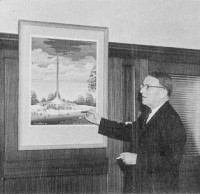 |
|
|
It might be pointed out here that the concept of a Fair pavilion
must be determined before the first lines can be drawn, both
in terms of the architecture and the exhibit itself.
In addition, a similar effort was required to adequately portray
the image of SKF Industries, an international organization concerned
with research, development and production of highly sophisticated
components. How to present this immensely technical story in
a manner which would permit even the layman to fully appreciate
the enormity of the study and application of anti-friction techniques
became the job of the concept designers.
After a period of time, it was finally agreed that the Pavilion
would itself present to the public a total feeling of
motion, while at the same time the show within the structure
would be paced to accentuate the "motion engineering"
aspects of the SKF philosophy.
|
|
PROGRESS PHOTOS ON SITE
The last pour on the building
foundation
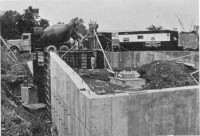 |
Iron workers setting the steel
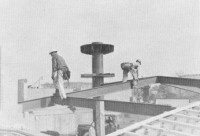 |
The architect on his regular tour
of inspection
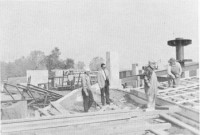 |
Framing out the sub roof
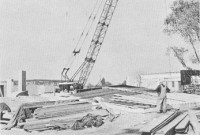 |
A look into the entrance way
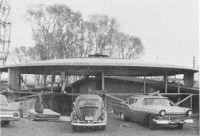 |
|
Since the space could handle no more than a thousand people
per hour, it was decided that a twofold presentation would be
made to the public; one, a brief but exciting exposition of the
relationship between motion engineering and each of us as we
work, play and live out the pattern of our daily lives; the second,
a technical presentation of the industrial value of the ball
and roller bearing as a principle of conveying people and objects
more smoothly and more comfortably than ever before, as well
as a schematic presentation of the technical problems generic
to the study of motion engineering.
Coincidentally, a study was made of the architectural ramification
of the structure in keeping with the exhibit concept and in relation
to the size and location of the site.
Based on the principle that the audience which attended the
SKF Pavilion would be drawn to a great degree from the passing
traffic and, as mentioned earlier, since it was desirable to
make it as convenient as possible for the audience to step into
the SKF Pavilion, a broad inviting access to the exhibit was
provided which oriented to the corner of the site exposed to
two crosswalks.
Similarly, an analysis was made of the methods by which the
greatest utilization could be made of the site without exceeding
the rules of the New York World's Fair which provide for adequate
landscaping of each Pavilion. In the final analysis, this problem
was solved by excavating the entire site and constructing the
interiors of the Pavilion several feet below grade.
|
|
In order to create the desired feeling of motion throughout
the structure, a floating parasol and soaring tower was designed,
and freed from the foundation through the use of a clear glass
band between the foundation walls and parasol; thus, a feeling
of motion was established in the major architectural elements.
At the same time, identification was provided for the SKF Pavilion
some eighty feet in the air by simple and tasteful signing of
the tower.
In order to further accentuate this feeling of motion, the
balance of the site became covered by a subtle roof structure
which called attention to the central parasol and tower.
Carrying this approach into the structure itself, an ovate
theater was designed to envelop the audience with motion and
the technical exhibit area was woven into a series of gently
curving walls and niches.
In evaluating the many techniques which were available through
which the story of motion engineering could be told, it became
apparent that the subject called for a technique which itself
utilized motion. With these thoughts in mind, a unique "show"
was visualized, scripted, and integrated through the use of multi-speaker
sound, music and sound effects and almost two hundred separate
animations. The show is presented mainly on a thirty-two foot
segment of the theatre wall. however, at one point the entire
theater is utilized.
This show is, in a sense, an abstraction of the principles
of motion engineering. In six minutes, some sixty people, seated
comfortably on a carpeted, tiered floor, learn of the beginnings
of motion engineering, its applications throughout the cross
section of American life today and are provided with just a hint
of the place that motion engineering will play in the future.
|
|
After this unique presentation, the audience is invited to walk
comfortably through the exhibit area, in which specifics of the
motion engineering story are picked up and described in detail.
Samples of every type of bearing are on display along with actual
sections of equipment which rely on roller bearings for long
and maintenance free life. Coincidentally, demonstrations of
laboratory research and quality control techniques are presented.
Finally, the breadth and scope of the international SKF complex
is described and located for the audience in graphic dimension. |
Two photos of interior display
units
|
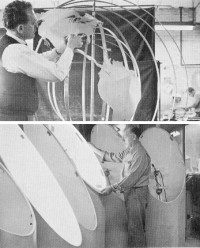
|
|
|
When the audience has left the SKF Pavilion, they have become
acquainted with the entire fascinating story and leave more well
informed, both on the nature and concern of SKF Industries and
the field of anti-friction study which SKF calls "motion
engineering." |
Source: SKF World's Fair
Newsletter |